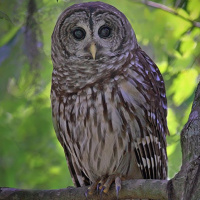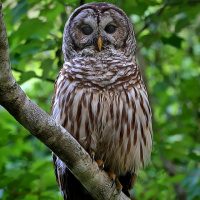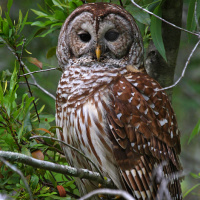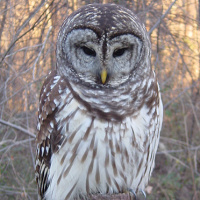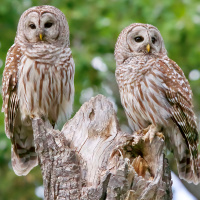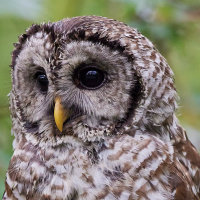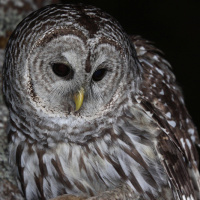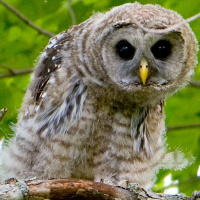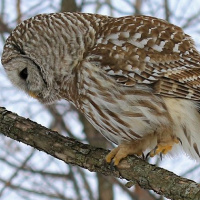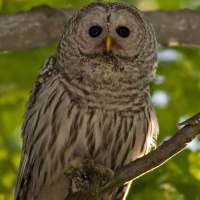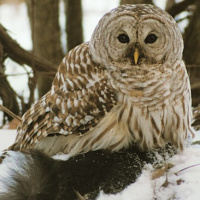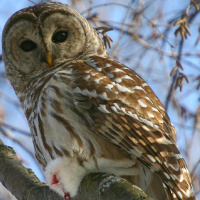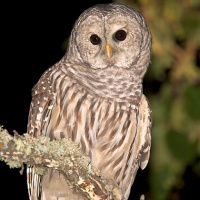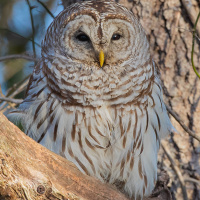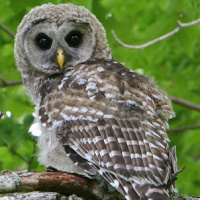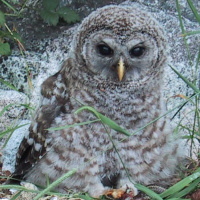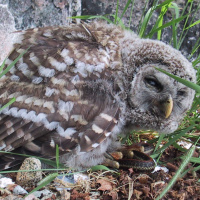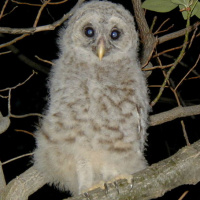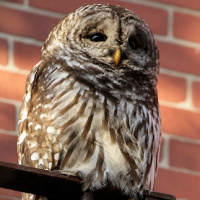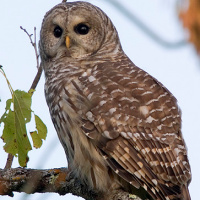Introduction
The Barred Owl is a fairly large owl with a large, rounded head with no ear-tufts. The species name varia is a form of the Latin word varius, meaning diverse. It has also been known as the Hoot Owl or Eight Hooter, and mistakenly called the Bard Owl.
Photo Gallery (20 pictures)
Sound Gallery
Information
Description: The facial disc is pale greyish-brown with darker concentric lines. The rim is not very prominent. Eyes are dark brown to
blackish-brown. The cere is pale horn, the bill pale yellowish with a slight greenish tint. The sides of the head and neck are barred light and dark.
The upperparts are brown to greyish-brown, scalloped with whitish bars on the crown, back and mantle. Wing-coverts are spotted whitish. Flight feathers are
barred whitish-buff and brown. The tail is brown or greyish-brown with 4-5 whitish bars.
Underparts are pale greyish-brown to dirty whitish. The upper breast and foreneck are densely barred light and dark. The rest of the underparts are boldly
streaked dark to rufous-brown.
Tarsi are feathered, and toes are almost totally feathered, the bare parts being yellowish-grey. Claws are dark horn with blackish tips.
Size: Length 40-63 cm. Wingspan 96-125cm. Tail length 312-380mm. Weight 500-1050g. Females are normally larger and heavier than males.
Habits: A nocturnal bird. Hides in dense foliage during the day, usually high up. May also roost on a branch close to a broad tree-trunk, or in a natural tree hole. May be very aggressive when defending a nest.
Voice: The Barred Owl is a highly vocal Owl giving a loud and resounding "hoo, hoo, too-HOO; hoo, hoo, too-HOO, ooo" which is often phrased as "Who, cooks, for-you? Who, cooks, for-you, all?" - The last syllable drops off noticeably. Like some other Owl species, they will call in the daytime as well as at night. The calls are often heard in a series of eight, then silence, when the Owl listens for a reply from other Owls. Other calls include "hoo-hoo, hoo-WAAAHH" and "hoo-WAAAHHH" used in courtship. Mates will duet, but the male's voice is deeper and mellower. Many other vocalisations are made which range from a short yelp or bark to a frenzied and raucous monkey-like squall.
Hunting & Food: A very opportunistic hunter, a Barred Owl can sometimes be seen hunting before dark. This typically occurs during the nesting season or on dark and cloudy days. A Barred Owl will use a perch, from where it dives upon its prey - meadow voles are its main prey, followed by shrews and deer mice. Other mammals include rats, squirrels, young rabbits, bats, moles, opossums, mink, and weasels. Birds are taken occasionally, including woodpeckers, grouse, quail, jays, blackbirds, and pigeons. They also eats small fish, turtles, frogs, snakes, lizards, crayfish, scorpions, beetles, crickets, and grasshoppers. Birds are taken as they settle into nocturnal roosts, because they cannot catch birds on the wing. They will also swoop down to the water's edge to catch frogs, other amphibians, and occasionally fish. Barred Owls are attracted to campfires and lights where they forage for large insects. Prey is usually devoured on the spot. Larger prey is carried to a feeding perch and torn apart before eating.
Breeding: Barred Owls call year-round but courtship activities
begin in February with breeding occurring between March and August. Males hoot and females
give contact calls. As the nesting season approaches, males chase after females giving a
variety of hooting and screeching calls. Males display by swaying back and forth, and
raising their wings, while sidling along a branch. Courtship feeding and mutual preening
also occur. Barred Owls nest in cavities and will also use abandoned Red-shouldered Hawk,
Cooper's Hawk, Squirrel, or Crow nests. Eggs number 2-4 and are white, and almost
perfectly round, with a slightly rough texture. They are likely laid every 2 to 3 days and
incubation begins with the first egg laid. Incubation period is 28-33 days. The Male
brings food to the female while she is on the nest. The Barred Owl is single-brooded but
has a long breeding season, which allows for laying of replacement clutches if the first
clutch or brood is lost. When the young leave the nest, at about 4 weeks, they are not able
to fly, but crawl out of the nest using their beak and talons to sit on branches. They fledge at 35 to 40 days. Once they lose their down,
there is no difference between adult and juvenile plumage.
Parents care for the young for at least 4 months, much longer than most other Owls. Young
tend to disperse very short distances, usually less than 10km, before
settling. Pairs mate for life and territories and nest sites are maintained for many years.
Mortality: Barred Owls have been known to live up to 23 years in captivity and 10 years or more in the wild. Most deaths are likely to be related to man (shootings, roadkills etc). Great Horned Owls are their only natural enemy.
Habitat: Barred Owls prefer deep moist forests, wooded swamps, and woodlands near waterways. Territories are 85-365 hectares.
Distribution: The Barred Owl is widespread in North America, they occur across most of the eastern half of the continent from Florida northward to southern Canada; they are also spreading westward in the north of their range. Their spread westward is causing concern as they may compete with the endangered Spotted Owl (Strix occidentalis). Northern populations may be partially migratory depending on food resources.
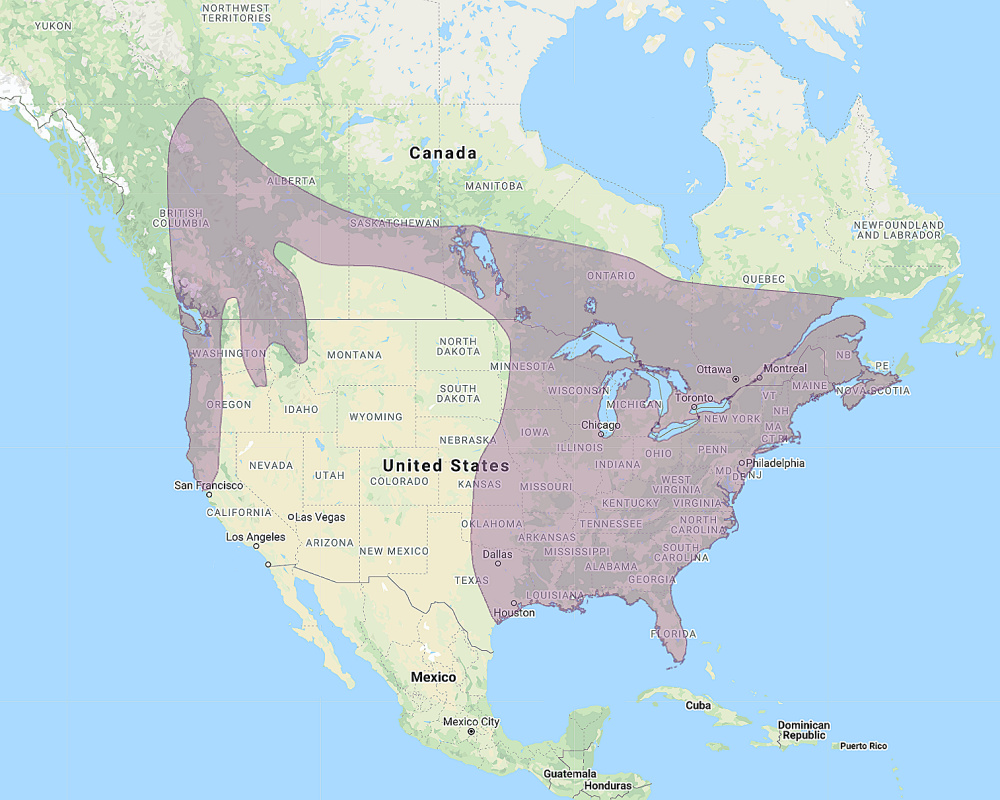
Range of the Barred Owl Strix varia
Status: Not threatened.
Original Description: Barton, Benjamin Smith. 1799. Fragment of the Natural History of Pennsylvania, p. 11.

